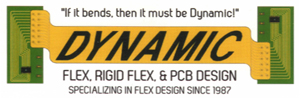The 7 Advantages of Flexible Printed Circuit Boards
Many believe that our imagination is the only limit regarding flexible printed circuit board applications. We thought about it for a while, and we couldn’t agree more. Most of these revealing moments occur when we are passing through a bunch of different specimens, and a particular form or level of flexibility sparks a new idea.
With flexible circuits, the magic moment comes when you’re working with a designer or group of engineers trying to solve a packaging problem, between different examples of flexible circuits and rigid-flexible designs. An instant after viewing a particular flexible circuit design, someone’s eyes will light up with an idea that could perhaps solve the matter, and then the brainstorming begins. It is exciting to be part of such a process!
As exciting as it is to design flexible circuits and rigid-flexible circuits, some people avoid using flexible circuits. We understand there is always a learning curve that comes with new technology. There are new materials to learn from, new design rules, and maybe even having to find an OEM. It can be intimidating. So, we thought we could go over some of the greatest benefits of using flexible circuits and rigid-flexible circuits to solve packaging problems. Perhaps these will spark some new ideas or provide an incentive to leaping flexible circuit board systems.
Advantages of flexible circuits
- They solve a packaging problem
The material can be folded around the corners, providing a three-axis connection, and has no discrete parts. The electronic components and functional elements can be positioned inside the product with the flexible circuit to be bent, folded and shaped to make the connections. That is where imagination comes in!
2. Reduce the required space and weight
Space, weight, and packaging, or SWaP, continue to be a hot topic in printed circuit board design. Flexible circuits can eliminate coarse wire connections and solders and, depending on components and structure, can save up to 60% in terms of weight and space. This significantly reduces package size.
3. Reduced assembly costs
Replacing thick wires and cables reduces or eliminates wiring which in turn reduces the assembly cost, labor, cost of the wire, etc. This option is worth exploring in more detail.
4. They facilitate dynamic flexing
The flexible printed circuit board, if designed properly, can withstand millions of flexes. Disk drives are a good example with tens to hundreds of millions of flex cycles. Another good example are the hinges connected to our laptops. These flexes will withstand tens of thousands of flexes over the lifetime of our computers.
5. Thermal Management
Polyamide materials can withstand applications at high temperatures. A thin polyamide can dissipate heat much better than thicker materials with less thermal conductivity. For this reason, there is significant growth in flexible circuit designs, especially in higher power and higher frequency designs.
6. Biocompatibility
Polyamide materials are an excellent choice for biological compatibility. For that reason, they are regularly used in both medical and portable applications. Advanced technology can also replace copper conductors with gold conductors, providing a completely bio-compatible option.
7. Increased Reliability and Less Opportunity for Operator Error
Replacing a rigid board and cable with a flexible or rigid design can significantly simplify system design by reducing the number and levels of interconnection required. Connections are controlled by a printed circuit eliminating the possibility of human error.
Manage using wires, cables, and rigid boards, or use a flexible circuit or rigid-flexible circuit?
Using rigid wires, cables and plates is a well-known solution and will always be a good starting point. It is when traditional methods simply do not fully resolve design and packaging constraints that you start thinking more seriously about flexible circuit solutions. Perhaps it’s about taking the first step with simple, flexible design and learning the standard materials and design tips and tricks to make sure your flexible circuit effectively flexes as intended. Or perhaps it is a matter of entering fully and facing a rigid-flexible multi-layer circuit with micro-track construction.
